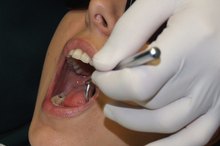What does fact checked mean?
At Healthfully, we strive to deliver objective content that is accurate and up-to-date. Our team periodically reviews articles in order to ensure content quality. The sources cited below consist of evidence from peer-reviewed journals, prominent medical organizations, academic associations, and government data.
- Centers for Disease Control and Prevention: Oral Cancer
- American Journal of Cancer Research: Squamous Cell Carcinoma – Similarities and Differences Among Anatomical Sites
- American Journal of Cancer Research: Squamous Cell Carcinoma – Similarities and Differences Among Anatomical Sites
The information contained on this site is for informational purposes only, and should not be used as a substitute for the advice of a professional health care provider. Please check with the appropriate physician regarding health questions and concerns. Although we strive to deliver accurate and up-to-date information, no guarantee to that effect is made.
Early Signs of Squamous Cell Mouth Cancer
Squamous cell carcinoma is the most common type of mouth cancer 2. According to 2006 information from the Merck Manual, approximately 40 percent of squamous cell growths begin on the floor of the mouth or on the tongue; 40 percent develop on the lower lip; and the remainder start on the roof of the mouth or the tonsils. Smoking, chewing tobacco and excessive drinking of alcohol place an individual at risk for developing mouth cancer. According to 2009 data from the Centers for Disease Control and Prevention, the five 5-year survival rate is 50 percent, but detecting the disease early improves the patient's prognosis 1.
If you are experiencing serious medical symptoms, seek emergency treatment immediately.
Squamous Cell Mouth Cancer
Squamous cell mouth cancer affects the upper layers of the skin. This type of cancer looks like fish scales under a microscope. Prolonged exposure to sun increases the risk of this type of cancer. People with fair skin and light hair are also at higher risk of squamous cell mouth cancer. Seek prompt medical attention if you experience symptoms of mouth cancer. Early recognition improves treatment outcomes.
- Squamous cell mouth cancer affects the upper layers of the skin.
- People with fair skin and light hair are also at higher risk of squamous cell mouth cancer.
Abnormal Surface Appearance
Signs of Lip Cancer
Learn More
Squamous cell cancers can be difficult to identify and may take various forms such as discolorations, sores and lumps. Cancers in the lining of the mouth, gums or tongue may appear as white or red patches rather than sores or lumps. Smokers may have a brown, freckle-like area on the lip instead. The most common sign is an open sore that does not heal. These sores, or ulcers, erode into underlying tissues and bleed intermittently. Growths may be white or red and may be smooth or raised. If a lump forms, it will be hard and immovable, unlike benign lumps that move freely. Suspicious lesions should be biopsied to determine if they are malignant.
- Squamous cell cancers can be difficult to identify and may take various forms such as discolorations, sores and lumps.
- Growths may be white or red and may be smooth or raised.
Pain
In later stages, mouth cancer begins to hurt when the nearby nerves are affected. The first sign of discomfort due to cancer of the tongue or the roof of the mouth is often a sore throat that does not go away after several weeks. As the disease progresses, the pain in the affected area becomes more persistent and may be referred to other parts of the body.
Alteration in Function
Diseases and Disorders of the Tongue
Learn More
Squamous cell cancer can cause symptoms that eventually interfere with the normal functions of the mouth due to discomfort and swelling in the affected area. The patient may complain of difficulties chewing or swallowing. He may have a persistent feeling that something is stuck in his throat, or have problems moving his tongue. Some patients complain of numbness in the tongue or other areas of the mouth, while others experience persistent hoarseness. As the disease progresses, swallowing becomes more difficult and the patient may have difficulty breathing because the airway becomes obstructed.
- Squamous cell cancer can cause symptoms that eventually interfere with the normal functions of the mouth due to discomfort and swelling in the affected area.
- Some patients complain of numbness in the tongue or other areas of the mouth, while others experience persistent hoarseness.
Related Articles
References
- Centers for Disease Control and Prevention: Oral Cancer
- American Journal of Cancer Research: Squamous Cell Carcinoma – Similarities and Differences Among Anatomical Sites
- American Family Physician. Assessing Oral Malignancies. https://www.aafp.org/afp/2002/0401/p1379.html
- Paderno A, Morello R, Piazza C. Tongue carcinoma in young adults: a review of the literature. Acta Otorhinolaryngol Ital. 2018;38(3):175-180. doi: 10.14639/0392-100X-1932
- Sultana J, Bashar A, Molla MR. New Management Strategies of Oral Tongue Cancer in Bangladesh. J Maxillofac Oral Surg. 2014;13(4):394-400. doi: 10.1007/s12663-013-0566-8
- Ram H, Sarkar J, Kumar H, Konwar R, Bhatt ML, Mohammad S. Oral cancer: risk factors and molecular pathogenesis. J Maxillofac Oral Surg. 2011;10(2):132-7. doi: 10.1007/s12663-011-0195-z
- Kim SM. Human papilloma virus in oral cancer. J Korean Assoc Oral Maxillofac Surg. 2016;42(6):327-336. doi: 10.5125/jkaoms.2016.42.6.327
- Center for Disease Control. Human Papillomavirus (HPV) and Cervical Cancer: An Update on Prevention Strategies Script. cdc.gov/std/hpv/hpvscript.pdf
- Oral Cavity and Oropharyngeal Cancer. American Cancer Society. https://www.cancer.org/cancer/oral-cavity-and-oropharyngeal-cancer.html.
- Genital HPV Infection - Fact Sheet. Centers for Disease Control and Prevention. https://www.cdc.gov/std/hpv/stdfact-hpv.htm.
Writer Bio
Marcy Brinkley has been writing professionally since 2007. Her work has appeared in "Chicken Soup for the Soul," "Texas Health Law Reporter" and the "State Bar of Texas Health Law Section Report." Her degrees include a Bachelor of Science in Nursing; a Master of Business Administration; and a Doctor of Jurisprudence.









